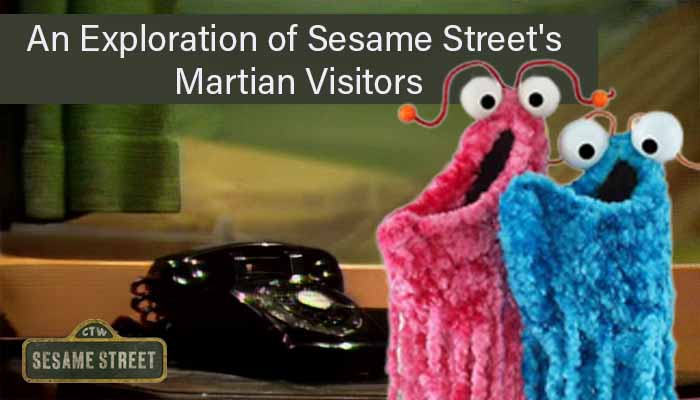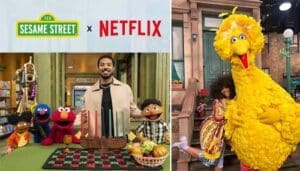The rhythmic, almost hypnotic chant of “Yip-yip-yip-yip… Uh-huh!” immediately transports generations of viewers back to the vibrant, educational world of Sesame Street. This distinctive vocalization belongs to the Martians, friendly and perpetually curious visitors from the planet Mars, who have been a quirky, beloved staple of the iconic children’s television show since their debut in 1972. Their unique blend of endearing oddity and innocent wonder has captivated both children and adults, solidifying their status as far more than mere background characters. The simplicity of their repetitive vocalization and their instantly recognizable visual appearance contribute significantly to their lasting presence in popular culture and their strong nostalgic resonance for adult audiences. This immediate recall, often triggered by a simple sound or image, demonstrates a powerful connection established early in viewers’ lives, a foundational element of their enduring appeal.
Who Are These Wonderful Wanderers?
The Martians, often referred to as the Yip Yips, possess an unmistakable physical presence that sets them apart. They are characterized by their “squid-like tentacles,” prominent “large eyes,” and curious “antennae,” which collectively give them an otherworldly yet approachable appearance. Their signature floating movement, a visual effect achieved through the clever use of “simple, controlled by two rods” puppetry, further enhances their alien, ethereal quality. This minimalist design, originating from repurposed “chenille hats” , was not a limitation but a deliberate choice that enabled their iconic floating movement and focused audience attention on their expressive eyes and distinct vocalizations. This simplicity proved highly effective for both visual appeal and pedagogical clarity, demonstrating a core principle of Muppet design where less can be more impactful.
Their primary mode of communication is their rhythmic, monotone chant of “Yip-yip-yip-yip… Uh-huh”. While seemingly limited, this vocalization becomes a versatile tool for expressing curiosity, confusion, and eventual understanding. When startled or scared, they have an endearing emotional reaction, quickly covering their faces with their lower jaw and making a funny “goom” sound , adding to their charm and vulnerability. The two Martians most frequently seen are affectionately named “Bob” and “Joe”. In the Dutch version of Sesame Street, they are known as “Sjoerd and Hendrik Marsman,” showcasing their international appeal.
The visionary behind the Yip Yips’ distinctive design was Caroly Wilcox, who “developed the first Martian puppets” and was responsible for “designing and building puppets and costumes for Sesame Street from 1969 until her retirement”. It is a testament to her ingenuity that these iconic figures were “originally chenille hats” , demonstrating the creative problem-solving inherent in early Muppet construction. Legendary puppeteers, including Jim Henson and Frank Oz, were among the many who skillfully brought the Yip Yips to life, imbuing them with personality through their movements and vocalizations. This chain of information reveals that the Yip Yips’ unique visual identity and movement were born from creative problem-solving and a focus on essential elements. This minimalist approach allowed the puppeteers to convey character and emotion primarily through subtle movements and vocalizations, rather than complex mechanics, making them highly effective and memorable for a young audience.
Earthly Adventures: A Martian’s Guide to Discovery
The Yip Yips’ adventures on Earth consistently follow a delightful pattern: they arrive, encounter common objects, and earnestly endeavor to understand them, often with the aid of their “special ‘Earth book'”. Their interactions are a masterclass in humorous yet insightful learning curves, providing a relatable model for young viewers.
One of their most iconic discoveries came in 1972 when they encountered a telephone. Their initial attempts to communicate involved polite greetings like “Hello.” When this proved ineffective, they humorously resorted to misidentifying it as a “cow” or a “cat,” accompanied by their classic “nope nope nope” refrain. It was only when the phone rang that they finally grasped its purpose as a “device for making sounds,” leading to their joyful “uh-huh” of understanding.
Their explorations continued with other everyday items. In 1972, they delved into the rhythmic ticking sounds of a grandfather clock. By 1979, they discovered the joy of music through a radio, getting “down to a funky beat”. A particularly memorable sketch from 1990 involved their encounter with a book, where their initial, curious sensory explorations included trying to “smell book” and “ear book” before they finally understood the concept of reading. Other notable, though perhaps less detailed, discoveries include the faucet in 1992, where they investigated how water emerges, and a toaster, watching toast pop up.
This consistent pattern of encountering an unknown object, making initial sensory observations, forming hypotheses, testing them, observing new data, and finally reaching a conclusion is a simplified, playful representation of the scientific method—observation, hypothesis, experimentation, conclusion—making complex cognitive processes accessible to very young children. Their journey from initial confusion and trial-and-error to eventual understanding and satisfaction models a relatable, iterative problem-solving process for young viewers.
Beyond their object discoveries, the Yip Yips have made other memorable appearances, including a surprise visit to Ernie and Bert, where they almost whisked Bert away to outer space for oatmeal. They also playfully interacted with Luis’s computer and even contributed their unique vocalizations to the “Old MacDonald Cantata”.
Here is a summary of some of the Yip Yips’ most iconic Earthly discoveries:
| Object | Year of Discovery (if known) | Key Interaction/Learning |
| Telephone | 1972 | Tried to talk to it, misidentified as animal, learned it makes sounds when it rings |
| Grandfather Clock | 1972 | Explored its rhythmic ticking sounds |
| Radio | 1979 | Discovered music and got “down to a funky beat” |
| Book | 1990 | Attempted to smell and hear it, then learned to read |
| Faucet | 1992 | Investigated how water comes out |
| Toaster | Unknown | Explored and watched it pop up toast |
Beyond the “Uh-Huh”: The Yip Yips’ Educational Legacy
The Yip Yips are not merely comedic relief; they are subtle yet profound educators. Their consistent trial-and-error approach serves as a powerful model for perseverance and problem-solving, teaching children that learning is an active process of experimentation. This approach, where they move from initial confusion to eventual clarity, normalizes the process of making mistakes, correcting them, and finding joy in discovery.
Their unique contribution to “Muppet book history” is particularly noteworthy. Their initial, seemingly “silly incorrect approaches” to a book – such as attempting to “smell book” or “hear book” – are a brilliant pedagogical strategy. These segments teach children about books as “material objects,” emphasizing sensory engagement and the physical properties of learning tools, rather than just their content. This approach implicitly validates non-traditional learning pathways, subtly encouraging children (and even adults and educators) to embrace diverse sensory and experiential methods beyond just visual or auditory instruction. This fosters a crucial growth mindset where errors are seen not as failures, but as integral steps in the discovery process.
The Yip Yips’ learning journey directly aligns with the broader educational goals of Sesame Street, which aims to foster “literacy and numeracy, emotional wellbeing, health and wellness, and respect and understanding”. Their progression from misunderstanding to understanding, where their “silly incorrect approaches” ultimately prove “key to learning,” validates diverse learning styles and encourages an innate curiosity about the world. The consistent journey from initial “nope nope nope” to eventual “uh-huh” fundamentally conveys to children that it is acceptable to not know, to make mistakes, and to approach learning in unconventional ways. By showcasing the Martians’ humorous, yet ultimately successful, trial-and-error process, the show implicitly teaches resilience and demonstrates that learning is an iterative journey.
From Screen to Shelf: The Enduring Appeal of the Yip Yips
The Yip Yips hold a lasting cultural footprint, driven by their distinctive charm and significant nostalgic resonance. Their status as “fun characters” is undeniable, and their slightly “weird” aesthetic set them apart from other Muppets, contributing significantly to their memorability. This inherent distinctiveness, rather than being a barrier, fostered a strong, almost cult-like following among children and, crucially, adults who remember them. Their “otherness” made them particularly memorable and ripe for nostalgic appreciation.
This emotional connection is a key driver of their enduring appeal, long after their target audience has grown up. The Yip Yips possess a significant power to “push the nostalgia feels incredibly hard for adults of a certain age”. Their continued relevance is evident in their popularity on social media platforms like TikTok, where videos featuring their classic telephone sketch trigger widespread memories. They also maintain a vibrant presence within active fan communities, where discussions and fan-made creations abound. Their simple, repetitive nature and unique vocalizations contribute to their high memorability and quotability, making them easily shareable and referenceable across generations.
The sustained demand for Yip Yip merchandise further underscores their lasting popularity. Early merchandise included Hot Topic T-shirts starting in 2003 and Gund bean-bag toys in 2004, with later additions like light switch plates, action figures, and even costumes. Modern collectibles, such as the Super7 ReAction figures, are explicitly designed for adult collectors, marketing their ability to “instantly take you back to a time when you or your children were learning the basics” , directly capitalizing on their nostalgic value. The vibrant fan creations, including plush replicas made with specific fabrics and crocheted Muppets, serve as a powerful testament to their dedicated and creative fanbase. This suggests that their departure from typical Muppet designs made them uniquely memorable. Their quirky, mostly non-verbal communication and exaggerated reactions to common objects created a humorous, endearing oddity that resonated deeply, making them more than just educational tools but enduring cultural touchstones that adults fondly recall and wish to own.
The Yip Yips have also been integrated into the broader Sesame Street universe through notable appearances and interactions with other beloved characters. They rode in a limo during the Elmopalooza special and assisted Big Bird in finding Ernie in outer space during a “Journey to Ernie” skit. Their interactions with iconic figures like Ernie, Bert, Luis, Maria, and Kermit demonstrate their integral, albeit often self-contained, place within the show’s rich tapestry.
A Timeless “Yip!”: Why We Still Love Our Martian Friends
The Yip Yip Martians of Sesame Street stand as simple yet profound educators, masters of curiosity, and enduring icons of childhood nostalgia. Their entire existence on the show—from their curious arrival and initial confusion to their trial-and-error learning and eventual “uh-huh”—encapsulates Sesame Street’s core educational philosophy: learning is an active, joyful, and sometimes messy process driven by curiosity, where mistakes are opportunities for growth.
They consistently teach fundamental concepts like observation, problem-solving, and the sheer joy of discovery, all delivered through their playful, relatable, and often hilarious scenarios. Their gentle confusion and eventual “uh-huh” moments mirror the universal human experience of learning and adapting to new information, making them timeless characters. This micro-narrative of curiosity, confusion, perseverance, and enlightenment is a direct reflection of the show’s overall pedagogical approach: meeting children where they are, validating their initial misunderstandings, and guiding them through a playful process towards knowledge.
The enduring popularity and nostalgic appeal of the Yip Yips are a testament to the effectiveness and timelessness of this character-driven, experiential learning model, making them a perfect embodiment of Sesame Street’s genius. These quirky, tentacled Martians continue to inspire wonder and a love for learning, proving that sometimes, the most profound and lasting lessons come from the most unexpected, “Yip-yip!” places.



